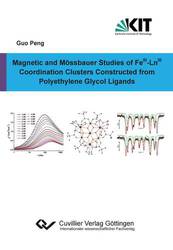| Fachbereiche | |
|---|---|
| Buchreihen (96) |
1378
|
| Nachhaltigkeit |
3
|
| Gesundheitswesen |
1
|
| Geisteswissenschaften |
2364
|
| Naturwissenschaften |
5406
|
| Mathematik | 229 |
| Informatik | 319 |
| Physik | 980 |
| Chemie | 1363 |
| Geowissenschaften | 131 |
| Humanmedizin | 243 |
| Zahn-, Mund- und Kieferheilkunde | 10 |
| Veterinärmedizin | 108 |
| Pharmazie | 147 |
| Biologie | 835 |
| Biochemie, Molekularbiologie, Gentechnologie | 121 |
| Biophysik | 25 |
| Ernährungs- und Haushaltswissenschaften | 45 |
| Land- und Agrarwissenschaften | 1004 |
| Forstwissenschaften | 201 |
| Gartenbauwissenschaft | 20 |
| Umweltforschung, Ökologie und Landespflege | 148 |
| Ingenieurwissenschaften |
1793
|
| Allgemein |
98
|
|
Leitlinien Unfallchirurgie
5. Auflage bestellen |
|
Erweiterte Suche
Magnetic and Mössbauer Studies of FeIII-LnIII Coordination Clusters Constructed from Polyethylene Glycol Ligands
Guo Peng (Autor)Vorschau
Leseprobe, PDF (810 KB)
Inhaltsverzeichnis, PDF (82 KB)
The discovery of SMMs not only offers unique opportunities to observed quantum effects, but also provides an avenue to develop novel molecular devices for information storage and quantum computing. However, the energy barrier to reorient the magnetization of reported SMMs is still very low, which hinders practical applications of SMMs and demands further exploration of ways to provide new SMMs for detailed studies of the magnetic relaxation phenomena. It is well known that the properties of SMMs strongly depend on total spin ground state (S) and magnetic anisotropy (D). Therefore, the combination of high spin ions (such as FeIII) and highly anisotropic ions (such as most of the LnIII ions) represents an ideal synthetic pathway to obtain SMMs. Both LnIII and FeIII ions can beclassified as hard acid based on the HSAB principle and they are strongly oxophilic, while the polyethylene glycol and carboxylic acid ligands supply many oxygen donors. Therefore, it is possible that combining mixed polyethylene glycol and carboxylic acid ligands along with LnIII and FeIII salts can lead to the assembly of FeIII-LnIII coordination clusters. Based on this approach, fifty three FeIII-LnIII coordination clusters (compounds 1-52, including 29a and 29b) have been reported in this thesis. Although the combination of LnIII in FeIII-based systems improve the SMM properties of the resulting compounds in most of cases, the contributions of LnIII in this system are still difficult to explain. Thus, the magneto-structural relationships of the resulting compounds have been established by the combination of single crystal XRD diffraction, magnetic susceptibility and micro-SQUID measurements in conjunction with, Mössbauer spectroscopy. The magnetic susceptibility measurements show that compounds 3, 9-11, 14, 18 and 29b exhibit slow relaxation of magnetization, indicating that these compounds might be SMM, but no peaks were observed above 1.8 K. Furthermore, compound 3 was confirmed as a SMM from micro-SQUID measurements. Compound 31 shows field-induced SMM behavior with an energy barrier of 48 K, while compound 38 displays typical SMM behavior with an energy barrier of 78 K, which is the highest energy barrier for FeIII-LnIII systems so far discovered. The Mössbauer measurements on compounds 29a and 29b reveal that a static magnetic field can quench the slow relaxation of magnetization generated by the anisotropic DyIII ions. Such effect has been only once reported in the literature. Compound 44 shows typical SMM behavior with an energy barrier of about 3.5 K. However, the Arrhenius plot of this compound shows an unusual feature, the energy barrier to magnetic relaxation is abruptly switched off and then abruptly switched back on again. This behavior is completely unprecedented and requires much further research. The results from Mössbauer spectra for compounds 42 and 44 illustrate the ability of Mössbauer spectroscopy to monitor and, with applied field, control the magnetic structure in molecular clusters. Moreover, it was observed for the first time how the interaction with strongly anisotropic DyIII ions resulted in the change of the spins (or magnetic moments) directions on iron centers. Compounds 49-52 present an FeIII 3LnIII 4 disk-like core with one LnIII captured at the center of an FeIII 3LnIII 3 wheel, which represent the first 3d-4f disklike coordination clusters incorporating FeIII.
| ISBN-13 (Printausgabe) | 9783954045655 |
| ISBN-13 (E-Book) | 9783736945654 |
| Buchendformat | A5 |
| Sprache | Englisch |
| Seitenanzahl | 188 |
| Umschlagkaschierung | glänzend |
| Auflage | 1. Aufl. |
| Erscheinungsort | Göttingen |
| Promotionsort | Karlsruhe |
| Erscheinungsdatum | 28.11.2013 |
| Allgemeine Einordnung | Dissertation |
| Fachbereiche |
Chemie
|
| Schlagwörter | Molecular magnetism, nanomagnetism, Single molecule Magnet, Coordination Clusters, Iron, Lanthanide, Relaxation |








